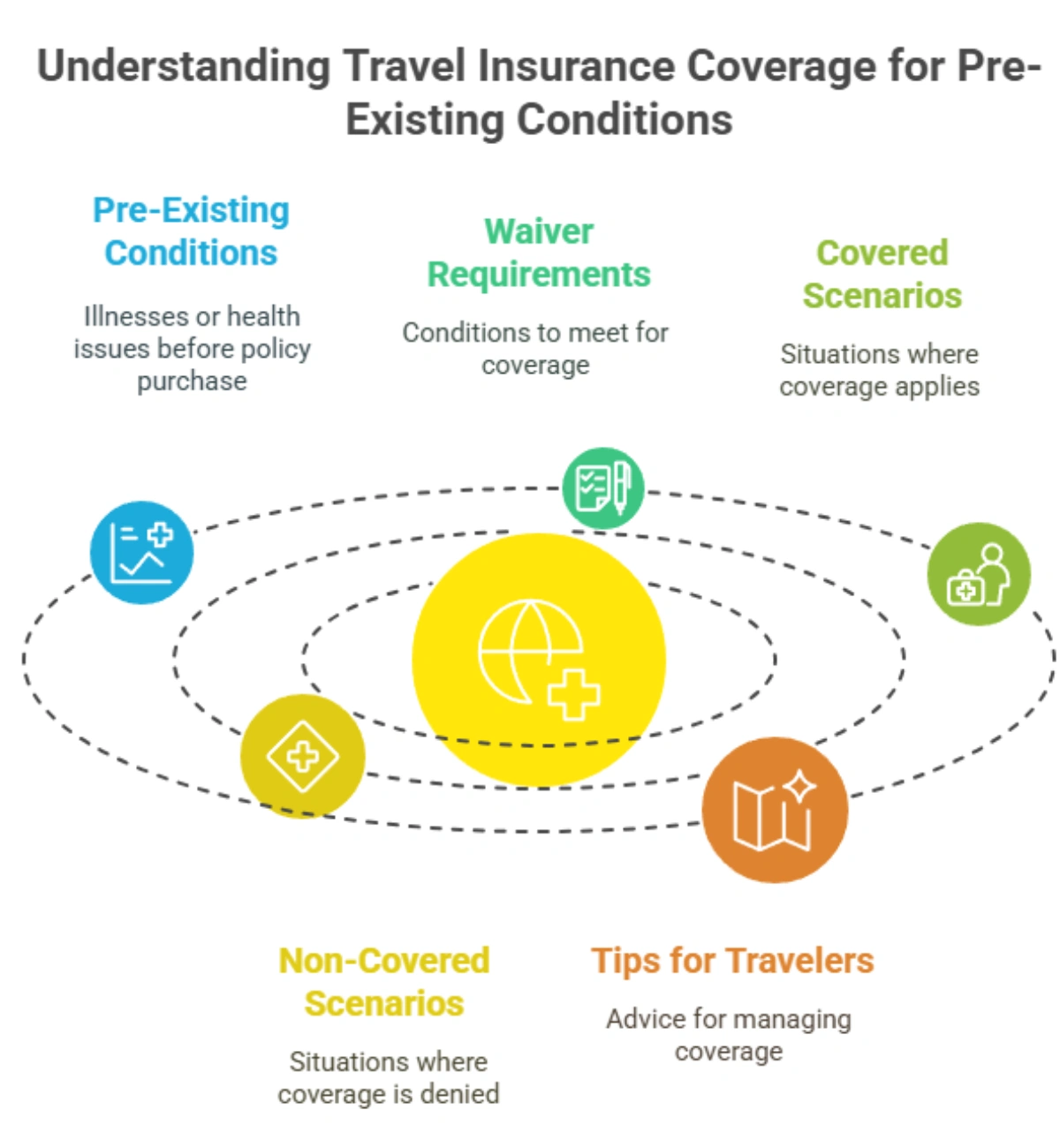Health insurance plans in the U.S. are required to cover pre-existing conditions under the Affordable Care Act. This means you can’t be denied coverage or charged more just because you have a health issue like diabetes, asthma, or cancer. Coverage begins as soon as your policy starts—no waiting periods for most plans. This law applies to individual, family, and employer-based plans. It gives peace of mind to millions, ensuring they get the care they need without facing discrimination or sky-high premiums.
What Are Pre-existing Conditions?
A pre-existing condition is any health issue—chronic or otherwise—that you had before applying for or enrolling in a health insurance plan. These can range from common conditions like diabetes, asthma, or high blood pressure to more complex diagnoses like cancer, heart disease, or mental health disorders. Before the ACA was signed into law in 2010, insurance companies could deny coverage, charge higher premiums, or exclude certain conditions from coverage based on your medical history. This left millions of Americans uninsured or underinsured, often facing financial ruin due to medical bills.
The ACA changed this by prohibiting insurers from denying coverage or charging more based on pre-existing conditions. As of 2025, this protection remains a cornerstone of the ACA, ensuring that no American can be turned away because of their health status. But with political debates and policy proposals like Project 2025 looming, there’s uncertainty about whether these protections could face challenges in the future.
Why Pre-existing Condition Coverage Matters
Imagine being diagnosed with a condition like rheumatoid arthritis at age 30. Without insurance, the cost of medications, doctor visits, and potential surgeries could easily exceed $20,000 a year. Now imagine applying for insurance only to be told you’re uninsurable because of your diagnosis. This was the reality for many before 2010. Today, the ACA ensures that people with pre-existing conditions have access to the same insurance plans as everyone else, with no lifetime or annual caps on benefits.
Here’s why this matters in 2025:
- Widespread Impact: According to the Kaiser Family Foundation, about 27% of non-elderly Americans (roughly 54 million people) have a pre-existing condition that could have led to coverage denial pre-ACA.
- Affordability: Enhanced subsidies through the Inflation Reduction Act of 2022 have made Marketplace plans more affordable, with four out of five HealthCare.gov consumers finding plans for $10 or less per month after tax credits.
- Health Equity: Protections for pre-existing conditions disproportionately benefit marginalized groups, including low-income individuals and people of color, who are more likely to rely on Medicaid or Marketplace plans.
How the ACA Protects People with Pre-existing Conditions
The Affordable Care Act, signed into law by President Barack Obama in 2010, revolutionized health insurance for those with pre-existing conditions. Here are the key protections:
- Guaranteed Issue: Insurers must offer coverage to everyone, regardless of health status. You can’t be denied a plan because you have a chronic illness or a past diagnosis.
- No Premium Surcharges: Insurers cannot charge higher premiums based on your medical history. This levels the playing field, ensuring fairness in pricing.
- Essential Health Benefits (EHBs): All Marketplace plans must cover a set of 10 essential benefits, including hospitalization, prescription drugs, and mental health services, critical for managing pre-existing conditions.
- No Lifetime or Annual Caps: Insurers can’t impose limits on how much they’ll pay for your care over your lifetime or in a single year, protecting those with high-cost conditions like cancer or HIV.
These protections apply to plans purchased through HealthCare.gov, state-based Marketplaces, and most employer-sponsored plans. However, some non-ACA-compliant plans, like short-term limited-duration insurance, may still exclude pre-existing conditions, so it’s crucial to read the fine print.
Health Insurance Options for Pre-existing Conditions
Navigating health insurance options can feel overwhelming, but there are several pathways to coverage for those with pre-existing conditions. Below, I’ll break down the main options, their benefits, and how to access them.
1. ACA Marketplace Plans
The Health Insurance Marketplace, accessible via HealthCare.gov or state-based exchanges, is the primary avenue for individuals seeking comprehensive coverage. Here’s what you need to know for 2025:
- Open Enrollment: Runs from November 1, 2024, to January 15, 2025, for coverage starting February 1, 2025.
- Enrollment Numbers: Over 24.2 million Americans enrolled in Marketplace plans for 2025, including 3.9 million new consumers, reflecting the popularity of these plans.
- Subsidies: Premium tax credits and cost-sharing reductions make plans affordable, especially for those with incomes between 100% and 400% of the federal poverty level. Enhanced subsidies, extended through 2025, have lowered premiums significantly.
- Plan Types: Marketplace plans come in tiers (Bronze, Silver, Gold, Platinum), with Silver plans often offering the best balance of premiums and out-of-pocket costs for those with pre-existing conditions.
- How to Enroll: Visit HealthCare.gov, answer questions about your income and household, and compare plans. You can also call 1-800-318-2596 or work with a certified navigator for free assistance.
2. Medicaid and CHIP
Medicaid and the Children’s Health Insurance Program (CHIP) provide free or low-cost coverage to low-income individuals, families, pregnant women, and people with disabilities. Unlike Marketplace plans, Medicaid has no open enrollment period, so you can apply anytime.
- Eligibility: Varies by state but typically includes those with incomes up to 138% of the federal poverty level in states that expanded Medicaid.
- Coverage: Includes doctor visits, hospital care, prescription drugs, and preventive services, making it ideal for managing chronic conditions.
- Recent Trends: Medicaid enrollment dropped from 92 million in 2023 to 79 million in 2024 due to the end of COVID-19 continuous eligibility provisions, but it remains a critical safety net.
- How to Apply: Check eligibility through HealthCare.gov or your state’s Medicaid agency. If you lose Medicaid due to income changes, you may qualify for a Special Enrollment Period (SEP) for a Marketplace plan.
3. Employer-Sponsored Insurance
About 60% of Americans get health insurance through their employer, and these plans must comply with ACA protections for pre-existing conditions.
- Benefits: Often include comprehensive coverage with lower premiums than individual plans, as employers typically cover part of the cost.
- Considerations: Check if your plan covers your specific medications or specialists, as employer plans vary in generosity.
- Enrollment: Usually occurs during your company’s open enrollment period or within 30 days of starting a new job.
4. Medicare
For those 65 and older or with certain disabilities, Medicare provides robust coverage for pre-existing conditions.
- Parts A and B: Cover hospital stays and doctor visits, respectively.
- Part D: Covers prescription drugs, crucial for managing chronic conditions.
- Medigap: Supplemental plans help cover out-of-pocket costs, but you must enroll during your initial enrollment period to avoid medical underwriting.
- How to Enroll: Visit Medicare.gov or call 1-800-MEDICARE (1-800-633-4227).
5. Non-ACA Plans
Some plans, like short-term limited-duration insurance or association health plans, are not required to cover pre-existing conditions. These are often cheaper but riskier, as they may exclude critical services or impose coverage limits. Always verify coverage details before enrolling.

Challenges and Threats to Pre-existing Condition Protections
While the ACA has been a game-changer, there are ongoing challenges and potential threats to these protections:
- Policy Proposals: Project 2025, a conservative policy blueprint, proposes rolling back ACA protections, including allowing insurers to offer plans that don’t cover essential health benefits or pre-existing conditions. This could lead to higher premiums and coverage gaps for millions.
- Subsidy Expiration: Enhanced Marketplace subsidies are set to expire after 2025 unless Congress extends them, potentially making coverage unaffordable for those with pre-existing conditions.
- Medicaid Reductions: Proposals to impose work requirements or block grants for Medicaid could reduce coverage for low-income individuals with chronic conditions.
- State Variations: Some states have not expanded Medicaid, leaving a coverage gap for low-income adults who don’t qualify for subsidies.
Tips for Choosing the Right Plan
Selecting a health insurance plan when you have a pre-existing condition requires careful consideration. Here are practical tips:
- Check the Formulary: Ensure your medications are covered under the plan’s drug list.
- Verify Provider Networks: Confirm that your doctors and specialists are in-network to avoid high out-of-pocket costs.
- Compare Out-of-Pocket Costs: Look at deductibles, copays, and coinsurance, not just premiums. Silver plans with cost-sharing reductions are often best for those with ongoing medical needs.
- Use Navigators: Free Marketplace navigators can help you compare plans and apply for subsidies. Find one at HealthCare.gov under “Find Local Help.”
- Plan Ahead: If you anticipate high medical costs, consider a Gold or Platinum plan with lower out-of-pocket expenses, even if premiums are higher.
Conclusion
Health Insurance Coverage for Pre-existing Conditions, Health insurance coverage for pre-existing conditions is more accessible than ever in 2025, thanks to the ACA’s robust protections. Whether you’re exploring Marketplace plans, Medicaid, or employer-sponsored insurance, there’s a path to affordable, comprehensive coverage. But with policy changes on the horizon, staying proactive is key. Use the tips in this guide, compare plans diligently, and don’t hesitate to seek help from navigators or brokers.
FAQ
Does health insurance cost more if you have pre-existing conditions?
No, thanks to the Affordable Care Act (ACA), insurers can’t charge higher premiums for pre-existing conditions in ACA-compliant plans (Marketplace, employer-sponsored, Medicaid). Everyone pays the same rate regardless of health history. However, non-ACA plans, like short-term insurance, may charge more or exclude conditions, so always check plan details.
How to get insurance for pre-existing conditions?
Enroll in an ACA Marketplace plan via HealthCare.gov during open enrollment (Nov 1–Jan 15) or a Special Enrollment Period. Medicaid, Medicare, or employer-sponsored plans also cover pre-existing conditions. Compare plans for your medications and doctors, apply subsidies for affordability, and use navigators for free help. Avoid non-ACA plans that may exclude conditions.
What is a pre-existing condition exclusion period?
A pre-existing condition exclusion period is when an insurance plan won’t cover treatments for conditions you had before enrolling. The ACA banned these for most plans (Marketplace, employer-sponsored), but non-ACA plans, like short-term insurance, may impose them, typically for 6–12 months. Always confirm coverage terms before enrolling to avoid gaps.
How far back do insurance companies look for pre-existing conditions?
For ACA-compliant plans, insurers don’t look back at your medical history to deny coverage or raise rates—pre-existing conditions are fully covered from day one. Non-ACA plans, like short-term insurance, may review 2–5 years of medical records to exclude conditions. Check plan terms, as look-back periods vary by insurer and state regulations.
Can health insurance refuse to pay for pre-existing conditions?
Health Insurance Coverage for Pre-existing Conditions, Under the ACA, Marketplace, Medicaid, Medicare, and employer-sponsored plans cannot refuse to pay for pre-existing conditions. Coverage starts immediately with no exclusions. However, non-ACA plans, like short-term or association plans, may refuse to cover pre-existing conditions or impose waiting periods. Always verify plan compliance with ACA rules to ensure full coverage for your needs.
What types of procedures are usually not covered by insurance?
Health Insurance Coverage for Pre-existing Conditions, Most ACA plans cover essential procedures, but common exclusions include cosmetic surgeries (e.g., elective plastic surgery), experimental treatments, and non-medically necessary procedures (e.g., certain fertility treatments). Dental, vision, and weight-loss surgeries may also be excluded unless deemed essential. Check your plan’s policy for specific exclusions, as coverage varies by insurer and state regulations.






